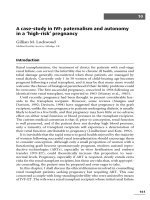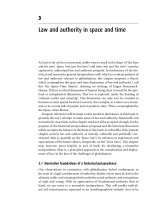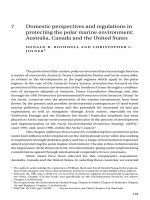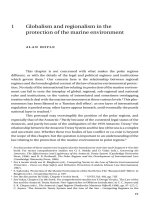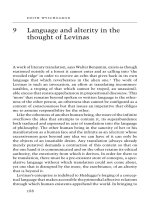Chart recognition and interpretation in document images
Bạn đang xem bản rút gọn của tài liệu. Xem và tải ngay bản đầy đủ của tài liệu tại đây (1.59 MB, 172 trang )
CHART RECOGNITION AND INTERPRETATION IN
DOCUMENT IMAGES
ZHOU YANPING
NATIONAL UNIVERSITY OF SINGAPORE
2003
CHART RECOGNITION AND INTERPRETATION IN
DOCUMENT IMAGES
ZHOU YANPING
(Ph.D Candidate, NUS)
A DISSERTATION SUBMITTED
FOR THE DEGREE OF DOCTOR OF PHILOSOPHY
DEPARTMENT OF COMPUTER SCIENCE
NATIONAL UNIVERSITY OF SINGAPORE
2003
Name: Zhou Yanping
Degree: Doctor of Philosophy
Dept: Department of Computer Science
Dissertation Title: Chart Recognition and Interpretation in Document Images
Abstract
In graphics recognition, chart recognition and interpretation is a procedure to change
scientific chart images into computer readable form. In this dissertation, we have
investigated four problem domains in it. First, we propose a hierarchical statistical-
model-based framework for chart recognition system. Second, we propose an improved
projection-based plot area detection method to detect plot areas and a Hough-based axis
detection algorithm to detect axes. Third, we propose a new approach for chart
classification and segmentation based on statistical modeling. A novel chart classification
approach based on Hidden Markov Models is proposed. A new approach for chart
segmentation using optimal path finding is also proposed. Fourth, we propose a novel
structure called zoned directional X-Y tree to hierarchically represent the text primitives
in charts. An algorithm of generating the zoned directional X-Y tree is presented. Both
results from chart segmentation and text primitive analysis are correlated for chart
interpretation.
Keywords : Graphics Recognition
Chart Recognition and Interpretation
Hough Transform
Statistical Modeling
Hidden Markov Model
Zoned Directional X-Y Tree
i
Acknowledgements
I would like to express my heartfelt gratitude and appreciation to my supervisor
Professor Tan Chew Lim for the advice and guidance he has provided throughout my
PhD work. I would also like to thank him for his great patience and encouragement. He
has been most approachable and helpful throughout the period.
I would like to thank Professors Leow Wee Kheng and Sung Kah Kay for their advice
and guidance during my graduate studies. I am grateful to Professor Blostein for the
instrumental discussion on chart recognition when I attended the 1
st
conference of
Diagram. I would like to thank members of thesis committees.
I am indebted to many of my colleagues and friends who have given me their support
and encouragement during my research work, especially to Long Huizhong, Zhang
Qinjun, Tang Menting, Xu Yi, Michael Cheng, Zhang Yu, Zhijian, Fusheng, Wang Bin,
etc.
Finally, this dissertation could not been possible without the support of my loving
family: my parents Zhou Baigen and Wu Facong, my husband Tom and my lovely son
Edward. I am forever grateful for their love, patience, and measureless support.
ii
This dissertation is dedicated to my father Zhou Baigen.
iii
Table of Contents
Acknowledgements……………………………………………………………… i
Table of Contents ……… iii
List of Figures.…………………………………………………………………… viii
List of Tables……………………………………………………………………… x
Summary… ……………………………………………………………………… xi
1 Introduction 1
1.1 Motivation…………………………………………………………………… 1
1.2 Challenges…………………………………………………………………… 2
1.3 Research Objectives…………………………………………………………. 5
1.4 Contributions and Dissertation Outline…………………………………… 6
2 Related Works 9
2.1 Graphics Recognition……………………………………………………… 10
2.1.1 Graphics Recognition Systems………………………………………… 11
2.1.2 Methodology of Graphics Recognition……………………………… 15
2.1.3 Scientific Chart Recognition………………………………………… 19
2.2 Other Related Techniques…………………………………………………… 20
2.2.1 Hough Transform ……………………………………………………… 20
iv
2.2.2 Hidden Markov Model………………………………………………… 21
3 Chart Recognition System 23
3.1 Analysis of Scientific Charts………………………………………………… 23
3.1.1 Knowledge from the Microsoft Excel Chart Tool……………………. 24
3.1.2 Definitions ……………………………………………………………. 27
3.2 Methodology of Chart Recognition System…………………………………. 32
3.2.1 Perceptual Organization on Charts…………………………………… 32
3.2.2 Methodology of the System………………………………………… 36
3.2.3 System Assumptions…………………………………………………. 40
3.2.4 Testing Data Collection………………………………………………. 41
3.3 Preprocessing…………………………………………………………………. 42
3.4 Summary…………………………………………………………………… 44
4 Chart Graphics Symbol Recognition 45
4.1 Plot Area Detection…………………………………………………………… 46
4.2 Chart Axes Detection ………………………………………………………… 48
4.2.1 Projection-based Axes Detection……………………………………… 48
4.2.2 Hough-Based Axes Detection with Geometric Analysis……………… 49
4.3 Experiments and Analysis……………………………………………………… 54
4.3.1 Results of Plot Area Detection………………………………………… 55
4.3.2 Results of Chart Axes Detection……………………………………… 60
4.4 Summary……………………………………………………………………… 66
v
5 Chart Classification and Segmentation 67
5.1 Dimension Classification of Charts………………………………………… 69
5.2 Framework of Chart Statistical Modeling…………………………………… 69
5.3 Model-based Chart Classification…………………………………………… 73
5.3.1 Feature Extraction………………………………………………………. 73
5.3.2 Chart Model Construction …………………………………………… 78
5.3.3 Type Classification by Chart Model Matching…………………………. 85
5.4 Chart Segmentation……………………………………………………………. 87
5.4.1 Chart Segmentation by Low-Level Heuristic Search …………………. 87
5.4.2 Chart Segmentation by Optimal Path Clustering……………………… 90
5.5 Experiments and Analysis……………………………………………………… 92
5.5.1 Experiments on Chart Classification……………………………………. 92
5.5.2 Experiments on Chart segmentation…………………………………… 94
5.6 Summary……………………………………………………………………… 98
6 Text Primitive Analysis and Chart Interpretation 99
6.1 Zoned Directional X-Y Tree Structure………………………………………. 101
6.2 Zoned Directional X-Y Tree Generation………………………………………104
6.2.1 Directional Transform for the Bounding Boxes……………………… 104
6.2.2 Recursive X-Y Cut by the Bounding Boxes………………………… 106
6.2.3 Linking Bounding Boxes with the Zoned Directional X-Y Tree………110
6.2.4 Algorithm of Zoned Directional X-Y Tree Generation……………… 111
6.3 Text Primitives Labeling …………………………………………………… 113
vi
6.3.1 Extracting Axes Tick Labels………………………………………… 113
6.3.2 Extracting Titles …………………………………………………… 116
6.4 Chart Interpretation…… ……………………………………………………. 116
6.4.1 Chart Interpretation by Correlating Value Points with Tick Labels … 117
6.5 Experiments and Analysis …………………………………………………… 122
6.5.1 Experiments on Axes Tick Labels Extraction………………………… 124
6.5.2 Experiments on Titles Extraction………………………………………125
6.6 Summary………………………………………………………………………127
7 Future Directions and Conclusion 129
7.1 Future Directions……………………………………………………………. 129
7.1.1 Broadening Chart Types for Model-based Chart Classification………129
7.1.2 More Label Types in Text Primitive Labeling……………………… 130
7.1.3 Integrating Low-Level Heuristic Search with Optimal Path Finding for
Chart Segmentation…………………………………………………………………… 130
7.1.4 Exploring Complex Feedback Mechanism …………………………. 131
7.1.5 Integrating More Knowledge Sources for Chart Recognition and
Interpretation………………………………………………………………… 131
7.2 Conclusion……………………………………………………………………. 132
vii
Appendices 135
A Hough Transform………………………………………………………………135
B Hidden Markov Models……………………………………………………… 138
Bibliography 142
viii
List of Figures
1.1 Some chart types in the Microsoft Excel Chart tool 3
1.2 Filling patterns in the chart generation tool of Microsoft Excel………… 3
3.1 Element entities in a chart …………………………………………………… 26
3.2 Definition illustrations in a two-dimensional-axes multiple-data-series chart
Figures……………………………………………………………………… 30
3.3 Areas defined in a three-dimensional-axes chart……………………………. 31
3.4 A perceptual test on a chart…………………………………………………. 35
3.5 Graphic primitives in charts show properties of perceptual relationship… 35
3.6 Flow chart of scientific chart recognition system………………………… 39
4.1 Algorithm of Plot Area Detection…………………………………………… 47
4.2 Hough-based Axes Detection Algorithm with geometric analysis…………. 50
4.3 Geometry illustration of the axes in charts…………………………………. 54
4.4 The results of plot area detection on an example image……………………. 58
4.5 Wrong detection results of plot area detection……………………………… 59
4.6 Successful examples of axes detection algorithms…………………………. 61
4.7 Successful results of Hough-based axes detection algorithms………………. 62
4.8 Unsuccessful results by Hough-based axes detection algorithm……………. 65
ix
5.1 Framework of statistical modeling for chart classification and segmentation….70
5.2 Shape analysis for a feature point……………………………………………… 75
5.3 Topologies of HMM-based chart models……………………………………… 82
5.4 Segmental K-means training algorithm for chart models……………………… 84
5.5 Viterbi algorithm for Hidden Markov Model…………………………………. 86
5.6 Algorithm of bar pattern segmentation by primitive extraction………………. 89
5.7 Algorithm of bar pattern segmentation by optimal path clustering…………… 91
5.8 Detecting the number of bar-series by optimal path clustering……………… 91
5.9 Results of bar pattern segmentation approaches on a separated bar chart…… 97
6.1 Structure overview of a zoned directional X-Y tree………………………… 103
6.2 Illustration of directional transform on a bounding box…………………… 105
6.3 Algorithm of directional transform for the bounding boxes………………… 106
6.4 Algorithm of Recursive X-Y Cut by the Bounding Boxes………………… 109
6.5 Algorithm of linking bounding boxes with the zoned directional X-Y tree… 110
6.6 Algorithm of zoned directional X-Y tree generation……………………… 112
6.7 Illustration of relationship between a value point and tick labels…………… 119
6.8 Chart interpretation by correlating the value points with the tick labels……. 120
6.9 Interface of the tabular data output of chart interpretation………………… 121
6.10 The results of text primitive labeling in a 3-D chart…………………………. 123
A.1 The mechanism of Hough transform………………………………………… 137
x
List of Tables
3.1 Testing data distribution of chart recognition system ……… …………… 41
4.1 Testing results of plot area detection methods ……………………………. 55
4.2 Testing results of axes detection algorithms for 2-D charts ………………. 64
4.3 Testing results of axes detection algorithms for 3-D charts……………… 64
5.1 Performance evaluation for dimension classification……………………… 92
5.2 Performance evaluation for type classification……………………………. 93
5.3 Results of detecting the number of data series of multiple-data-series
charts……………………………………………………………………… 95
5.4 Results of detecting bar patterns for separated bar charts……………… 96
6.1 Results of vertical and horizontal axes tick labels extraction……………… 124
6.2 Results of directional axes tick labels extraction…………………………. 125
6.3 Results of axes titles and figure titles extraction…………………………… 126
xi
Summary
Chart recognition and interpretation is a procedure to change scientific chart images
into computer readable form such as tabular data. Unfortunately there is little work
reported on it due to the difficulties and challenges in four main issues: the great
diversity of chart types, the flexibilities in the structural arrangement, the difficulty in
describing the syntax and semantics of complex charts and the difficulty in dealing with
degraded, distorted or noisy input.
In this dissertation, we have investigated four problem domains in chart recognition:
chart recognition system, chart graphic symbol extraction, chart classification and
segmentation, text primitive analysis and chart interpretation.
Chart recognition system: We propose a hierarchical statistical-model-based
framework for scientific chart recognition system. First, the knowledge of chart
generation software is explored and notation conventions of a scientific chart from both
generation and recognition point of views are defined. Second, investigation in
psychological aspect and human visual perception on charts deduces three arguments that
are the backbone of the proposed framework. Our testing data is constructed with more
than 500 chart images from technical journals that are scanned by 300 dpi.
Chart graphic symbol extraction: Chart graphics symbol recognition of current
work includes plot area detection and axis detection. We propose an improved
xii
projection-based plot area detection method to detect plot areas. For axis detection, we
propose a Hough-based axis detection algorithm that combines geometric analysis of 2-D
and 3-D axes.
Chart classification and segmentation: We propose a new approach for chart
classification and segmentation based on statistical modeling. Four chart models
including separated bar model, contiguous bar model, single-line-series line model and
multiple-line-series line model are constructed and trained using a segmental K-means
algorithm to model the semantics of chart stage area. Charts are classified by choosing
the chart model with the largest posteriori probability. The best state path for that model
is also obtained by applying Viterbi algorithm. Two kinds of classifications, dimension
classification and type classification, are addressed. We also propose a new approach for
chart segmentation using optimal path finding. Two chart segmentation problems are
addressed, including detecting the number of data series and bar pattern segmentation.
Text primitive analysis and chart interpretation: We propose a zoned directional
X-Y tree structure to hierarchically represent the text primitives in charts. An algorithm
of generating the zoned directional X-Y tree is presented. The algorithm includes three
procedures: directional transformation of the bounding boxes, recursive X-Y cut by the
bounding boxes and linking the bounding boxes with the X-Y tree. A scheme combining
X-Y tree searching and traversing with structural analysis is proposed to label the text
primitives in a chart. Three kinds of axes tick labels are extracted: vertical axes tick
labels, horizontal axes tick labels and directional axes tick labels. The extraction of the
axes titles and the figure titles is also presented. Finally, both the result from chart
segmentation and text primitive analysis are correlated for chart interpretation.
1
Chapter 1
Introduction
1.1 Motivation
In our society today, paper is still an important medium for exchanging information in
literary, scientific or commercial fields. Most of the paper-based documents are in the
raster file style. Thus by changing the paper-based documents into a computer readable
electronic format, it can broaden the scope of our information source. The growing need
for information sharing among different work and research communities and the
development of new technologies for digital information diffusion have increased the
demand for tools for automatically converting paper-based information into computer
readable information.
As far back as 1985, it was stated that about one trillion statistical graphs were printed
each year [114]. Many more of such graphs are expected with the proliferation of printed
paper documents today. Most of statistical graphs appearing in scientific papers are
scientific charts or diagrams. Like forms or tables which convey information from
structurally arranged data, scientific charts are also a very powerful representation tool in
the scientific research area because people understand symbolic graphs better and faster
2
than the corresponding text [115]. The processing procedure to change scientific chart
images into computer readable form is scientific chart recognition. The ensuing
processing procedures like understanding the meaning of the scientific charts or changing
recognized electronic charts into other computer readable forms such as tabular data form
are in the field of scientific chart interpretation. There is little research work and
practical products reported on recognizing and interpreting scientific chart images in
comparing with those on the table or form recognition. In the next section, we discuss the
challenges and difficulties in recognizing and interpreting scientific chart images that lie
in the following main four aspects.
1.2 Challenges
The Great Diversity of Chart Types
Many text-processing software packages have built-in features or tools for generating
charts and graphs, such as Microsoft Excel and Word, Harvard Graphics, Corel Chart,
etc. 2-D or 3-D graphical objects such as lines, circles, rectangles, cones, cylinders,
pyramids and spheres are used in these scientific chart generation tools as one of the
customized features. Figure 1.1 shows some chart types used in the Microsoft Excel
Chart tools. Charts can be classified into color charts or monotonic charts. Combinational
charts in which different chart graphical objects are used to present complex data also
appear frequently in the data presentation. Different patterns and textures can also be
used for filling the graphical objects like bars and pies to denote different categories in
the scientific charts. For instance, there are 48 textured patterns in the chart generation
tools of Microsoft Excel chart tools as shown in figure 1.2. The color variations for the
3
Figure 1.1: Some chart types in the Microsoft Excel Chart tool: (1): clustered column.
(2): open-high-low-close. (3): stacked column. (4): volume-high-low-close. (5): 3-D
column. (6): column with a cylindrical shape. (7): column with a conical shape. (8):
column with a pyramid shape. (9): line. (10): line with markers displayed on each data
point. (11): pie. (12): pie with a 3-D visual effect. (13): scatter. (14): high-low-close.
(15): area. (16): area with a 3-D visual effect.
Figure 1.2: Filling patterns in the chart generation tool of Microsoft Excel. There are 48
texture patterns that can be applied on the surfaced graphical objects such as bars,
columns, pies and areas.
4
foreground and the background inside each pattern can give birth to a large number of
colorful patterns. Consider applying 64 colors on the textured patterns. There will be
193,536 colorful textured patterns generated. Therefore for a simple bar chart with only
one data series, different colorful textured patterns in the bars lead to a total of 193,536
different bar charts, not to mention bar charts with several data series.
The Flexibilities in the Structural Arrangement
Even in the same chart type, charts may look very different from each other due to the
positional translation or rotation of graphical or text objects. For example, most chart
generation tools offer users with various customization functions, such as putting the title
at an arbitrary position of the chart, etc.
The Difficulty in Describing the Syntax and Semantics of Complex Charts
While most of the two-dimensional charts have simple syntactic and semantic meaning
like bar charts and line charts, the meaning for most of the three-dimensional charts is
always difficult to describe for further chart recognition or interpretation.
The Difficulty in Dealing with Degraded, Distorted or Noisy Input
Poor image quality introduced by an inappropriate acquisition of an image such as bad
illumination, noise introduced by an external device or vibrations in the acquisition
device, image degrading caused by previous processing steps, increases the difficulty of a
recognition procedure. Typical degradations appearing in the document image are: gaps
due to the lack of ink which causes the discontinuity of lines, extra large noise caused by
ink blobs, or image warping at the left or right side caused by uneven scanning, etc.
5
Thus to generate a generic type-independent chart recognition system is a highly
challenging problem. The difficulties led us to the research objectives given in the next
section.
1.3 Research Objectives
The task of meeting the challenges set out in the preceding subsection is indeed daunting
and is not very much researched so far in the document image analysis community. It is
impossible to address the entire problem within the time frame of the present
dissertation.
With a practical scope in mind, this dissertation aims to investigate four problem
domains in chart recognition by investigating the recognition and interpretation of two
major kinds of charts: bar charts and line charts. Furthermore, it consists of four main
objectives:
1. Chart recognition system: Propose a sound scientific chart recognition framework
and theoretical analysis for the foundation of the proposed chart recognition
framework.
2. Chart graphic symbol extraction: Investigate two intermediate-level graphical
processing procedures: plot area detection and axes detection.
3. Chart classification and segmentation: Investigate two kinds of chart
classification: dimension classification and type classification. Dimension
classification is to classify a chart into a 2-D chart or a 3-D chart. Type
classification is to classify a 2-D chart into one of the four chart categories: the
single-line-series chart, the multiple-line-series chart, the separated bar chart and
6
the contiguous bar chart. Chart segmentation involves two issues: detect the
number of data series and bar pattern segmentation.
4. Text primitive analysis and chart interpretation: The problem of labeling the
structural texts in a chart is also explored. Text primitive analyses involving
extraction of the axes tick labels, the axes titles and the figure titles are proposed
in our work. The segmented axis tick labels are essential for interpreting a chart
and transferring chart data into a tabular output by correlating with the value
points from chart segmentation.
1.4 Contributions and Dissertation Outline
We aim to make contributions from four problem domains that we will investigate in this
dissertation: chart recognition system, chart graphic symbol extraction, chart
classification and segmentation, text primitive analysis and chart interpretation.
In the problem domain of chart recognition system, the contributions will be as
follows:
1. We will propose some notation definitions of a scientific chart from a recognition
point of view. Notational conventions from both generation point of view and
recognition point of view facilitate the whole chart recognition procedure.
2. We will give theoretical contributions in constructing a chart recognition system
by investigating the mechanism of human visual perception on chart recognition.
We will examine the arguments that form the principles and backbone of our chart
recognition problems.
3. We will propose a hierarchical statistical-model-based chart recognition
framework which focuses on the intermediate level of vision.
7
4. We will collect a large set of test data. The procedure of setting up the testing data
for our system is not difficult but tedious. In future work, the test data set will be
made publicly available for future studies.
In the problem domain of chart graphics symbol recognition, the contributions will be
as follows:
5. We will propose an improved projection-based approach for plot area detection.
6. We will present a method of axes detection with Hough feature clustering and
geometric analysis in our work to detect 2-D and 3-D axes.
In the problem domain of chart classification and segmentation, the contributions will
be as follows:
7. We will propose a new framework for chart classification and segmentation based
on statistical modeling.
8. We will propose a model-based chart classification approach. This includes feature
extraction with feature point segmentation and analysis, construction and train of
HMM-based chart models, type classification by chart model matching.
9. We will propose a new approach for chart segmentation by optimal path clustering
and finding.
In the problem domain of text primitive analysis and chart interpretation, the
contributions will be as follows:
10. We will propose a zoned directional X-Y tree structure to hierarchically represent
the text in graphical documents. The proposed zoned directional X-Y tree is a
generalized version of the classical X-Y tree which considers only orientations in
the vertical and the horizontal directions.
8
11. We will propose a method of directional transforming the bounding boxes in the
image space to the ρ-space.
12. We will propose a recursive X-Y cut segmentation algorithm using original and
transformed bounding boxes to generate the zoned directional X-Y tree for text
primitives.
13. We will present an approach of combining X-Y tree searching and traversing with
structural analysis to label the text primitives in a chart. Detailed procedures to
extract axes tick labels and titles will be illustrated.
14. We will present a method of correlating value points with axis tick labels in order
to interpret chart data into a tabular format for bar charts and line charts.
The above targeted contributions will be addressed in the dissertation which is
outlined below:
A survey of graphics recognition and related works will be conducted in chapter 2.
Chart recognition system will be addressed in the chapter 3. In chapter 4, intermediate-
level chart graphical processing such as plot area detection and axes detection are
proposed. Chart classification and segmentation using statistical modeling are presented
in the chapter 5. In chapter 6, the problems of text primitives analysis and chart
interpretation are addressed. We conclude the dissertation and point out the further
directions of our work in chapter 7.
9
Chapter 2
Related Works
Scientific chart recognition is a branch of the application of graphics recognition which
in term is a sub-area of document image analysis (DIA). Document image analysis is
“the study of converting documents from paper form to an electronic form that captures
the information content of the document” [10] and “ the practice of recovering the
symbolic structure of digital images scanned from paper or produced by computer” [82].
The wide ranging research interests and topics due to the great variety of the
document contents have led to the emergence of the field of document image analysis.
These active studies and practices are classified into two main categories in terms of the
document contents: one is the mostly-text DIA such as optical character recognition [55,
96, 105], handwritten character recognition [48, 70, 80] and document layout analysis
[63, 103], etc. The other category is the mostly-graphics DIA, namely, graphics
recognition. Within the last two decades, we have seen conferences and workshops
organized for the sole purpose of document image analysis research. These include the
international conference on document analysis and recognition (ICDAR), the
international workshop on document analysis systems (DAS), the international workshop
on graphics recognition (GREC), the SPIE conference on document recognition and
10
retrieval, etc. A new journal, namely, international journal of document analysis and
recognition (IJDAR) also came into being following the growing interest in the field.
Comprehensive surveys and research studies on the document image analysis can be
found in [3, 11, 12, 41, 82, 107].
2.1 Graphics Recognition
Although text is no doubt the major source of document data, a large number of graphs,
photographs, pictures, and diagrams are also accessible in our daily lives. Just like the
old adage that "a picture is worth a thousand words", information in pictorial
representation is much more complex and unwieldy than that in textual representation.
Graphics are complex and difficult to interpret for machines, while machines can
recognize characters quite easily.
We focus on graphs and diagrams which are concise and abstract pictorial
representations of information. Maps, scientific charts, engineering drawings, and
sketches are all examples of graphs and diagrams. For example, people use scientific
charts such as line charts and bar charts to intuitively convey a clear analysis of
commercial data and research data. In architecture and engineering design, the technique
of computer aided design (CAD) is extensively used to produce a large number of
engineering drawings, electrical circuit diagrams, flow charts and process diagrams to
facilitate the communication among human designers, producers and engineers. The goal
of graphics recognition is to convert information from its paper-based graphical
representation into computer interpretable data.




